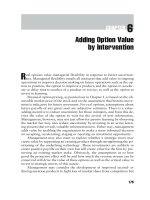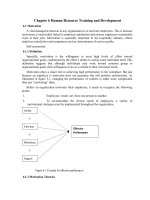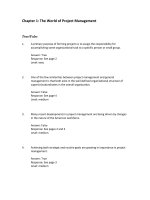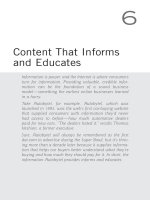Lecture Project management in practice - Chapter 6: Estimating project, times and costs
Bạn đang xem bản rút gọn của tài liệu. Xem và tải ngay bản đầy đủ của tài liệu tại đây (456.84 KB, 16 trang )
CHAPTER 6
Estimating Project,
Times and Costs
Copyright © 2013 McGraw-Hill Education (Australia) Pty Ltd
Pearson, Larson, Gray, Project Management in Practice, 1e
6-1
Learning Elements
6.1 Understand that estimating can be
carried out to differing levels of detail
and accuracy.
6.2 Apply any number of estimating
techniques to assist in scoping and
planning a project.
6.3 Understand the concept of contingency
versus padding.
Copyright © 2013 McGraw-Hill Education (Australia) Pty Ltd
Pearson, Larson, Gray, Project Management in Practice, 1e
6-2
RECAP. Leading on from Step 4. Estimating:
Moving towards a draft budget and schedule
ESTIMATING
The journey from WBS to estimating and the creation of the budget
schedule and resource matrix
Copyright © 2013 McGraw-Hill Education (Australia) Pty Ltd
Pearson, Larson, Gray, Project Management in Practice, 1e
6-3
Estimates are needed to:
– Support good decisions
– Determine whether the project is worth doing
– Determine how long the project should take and
its overall cost
– Schedule work
– Determine the resource required (human and
other)
– Develop time-phased budgets (cash flow)
– Establish the project baseline
– Determine how well the project is progressing
Copyright © 2013 McGraw-Hill Education (Australia) Pty Ltd
Pearson, Larson, Gray, Project Management in Practice, 1e
6-4
What is being estimated?
• Resources
• Durations
• Costs
Copyright © 2013 McGraw-Hill Education (Australia) Pty Ltd
Pearson, Larson, Gray, Project Management in Practice, 1e
6-5
Estimating Guidelines for
Time, Costs and Resources
Consider:
• Responsibility
• Use several people to estimate
• Normal conditions
• Time units
• Independence
• Contingencies
• Carrying out a risk assessment
• Cost of Quality (CoQ)
Copyright © 2013 McGraw-Hill Education (Australia) Pty Ltd
Pearson, Larson, Gray, Project Management in Practice, 1e
6-6
Top-down versus Bottom-up
Estimating
Top-down approach
Are usually derived from someone who uses experience
and/or information to determine the project duration and
total cost.
Bottom-up approach
Can serve as a check on cost elements in the WBS by
rolling up the work packages and associated cost
accounts to major deliverables at the work package level.
Hybrid – phase estimating
Used when an unusual amount of uncertainty surrounds a
project and it is impractical to estimate times and costs for
the entire project.
Copyright © 2013 McGraw-Hill Education (Australia) Pty Ltd
Pearson, Larson, Gray, Project Management in Practice, 1e
6-7
Methods for Estimating Project
Costs, Time and Resources
•
•
•
•
•
•
Consensus methods
Expert judgment
Alternative analysis
Parametric estimating
Analogous method
3-point estimate
Copyright © 2013 McGraw-Hill Education (Australia) Pty Ltd
Pearson, Larson, Gray, Project Management in Practice, 1e
6-8
Methods for Estimating Project
Costs, Time and Resources(cont.)
•
•
•
•
•
•
Vendor bid analysis
Estimating tools and systems
Function point methods
Learning curves
Template methods
Range estimating
Copyright © 2013 McGraw-Hill Education (Australia) Pty Ltd
Pearson, Larson, Gray, Project Management in Practice, 1e
6-9
Analogous Estimating
‘Analogous estimating is a technique for
estimating the duration or cost of an activity
or a project using historical data from a
similar activity or project.
‘Analogous estimating uses parameters from
a previous, similar project, such as duration,
budget, size, weight, and complexity, as the
basis for estimating the same parameter or
measure for a future project.’
(PMI 2013, p. 169)
Copyright © 2013 McGraw-Hill Education (Australia) Pty Ltd
Pearson, Larson, Gray, Project Management in Practice, 1e
6-10
Parametric Estimating
‘Parametric estimating is an estimating
technique in which an algorithm is used to
calculate cost or duration based on historical
data and project parameters.
‘Parametric estimating uses a statistical
relationship between historical data and other
variables (e.g. square footage in construction)
to calculate an estimate for activity
parameters, such as cost, budget and
duration’.
(PMI 2013, p. 170)
Copyright © 2013 McGraw-Hill Education (Australia) Pty Ltd
Pearson, Larson, Gray, Project Management in Practice, 1e
6-11
Three-point Estimate
Also known as the PERT method.
Optimistic + (4 x Most Likely) + Pessimistic
6
Copyright © 2013 McGraw-Hill Education (Australia) Pty Ltd
Pearson, Larson, Gray, Project Management in Practice, 1e
6-12
Summary of Estimating Tools
Copyright © 2013 McGraw-Hill Education (Australia) Pty Ltd
Pearson, Larson, Gray, Project Management in Practice, 1e
6-13
Level of Detail in Estimating
The estimating trumpet
Copyright © 2013 McGraw-Hill Education (Australia) Pty Ltd
Pearson, Larson, Gray, Project Management in Practice, 1e
6-14
Refining Estimates
Reasons for adjusting estimates
• Interaction costs are hidden in estimates.
• Normal conditions do not apply.
• Things go wrong on projects.
• Changes in project scope and plans.
Adjusting estimates
• Time and cost estimates of specific activities are
adjusted as the risks, resources and situation
particulars become more clearly defined.
Copyright © 2013 McGraw-Hill Education (Australia) Pty Ltd
Pearson, Larson, Gray, Project Management in Practice, 1e
6-15
Key Terms
•
•
•
•
•
•
•
•
•
•
•
•
•
•
•
•
3-point estimate
bottom-up estimates
contingency
Cost of Quality (CoQ)
Delphi Method
direct costs
estimating tools
function points
indirect costs (G&A or overhead costs)
learning curve
padding estimates
PERT method
phase estimating
range estimating
templates
top-down estimates
Copyright © 2013 McGraw-Hill Education (Australia) Pty Ltd
Pearson, Larson, Gray, Project Management in Practice, 1e
6-16









